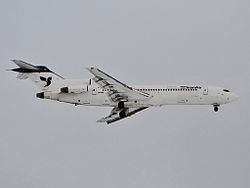Crew 12 Survivors 27 Number of deaths 78 Passenger count 93 | Passengers 93 Fatalities 78 Date 9 January 2011 Injuries (nonfatal) 26 Survivor 27 | |
 | ||
Summary Impacted ground on go-around Similar Hewa Bora Airways Flight 952, Asiana Airlines Flight 991, RusAir Flight 9605, 2011 Royal Moroccan Air Force, First Air Flight 6560 | ||
Iran Air Flight 277 was a passenger flight which crashed near Urmia Airport, West Azerbaijan Province, Iran, on 9 January 2011. At least 77 of the more than 100 aboard died. The aircraft involved, a Boeing 727-286Adv, was operating Iran Air's scheduled domestic service from Mehrabad International Airport, Tehran, to Urmia. It crashed after a go-around was initiated during final approach, in poor weather conditions.
Contents
Aircraft
The aircraft involved in the accident was a Boeing 727, registration EP-IRP, built in 1974. The aircraft had spent a long time out of service. It was impounded at Baghdad, Iraq from 1984 to 1990, and then placed in storage from 1991 to 2002. It was then overhauled and returned to service.
Accident
The flight was travelling between Tehran and Urmia. It took off from Mehrabad International Airport at 18:15 local time (15:15 UTC), more than two hours later than scheduled because of bad weather at Urmia, and crashed on final approach near Urmia Airport. The accident occurred at around 19:45 local time (16:15 UTC), and was reportedly caused by poor weather. The aircraft had missed its first attempt at landing; it crashed either during a go-around, or while attempting to return to Tehran. The weather conditions at the time of the accident included snow and low visibility. Upon impact, the aircraft broke into multiple pieces, though without fire or explosions. There were differing initial reports as to the type of aircraft that crashed, with either a Fokker 100 or a Boeing 727 said to have crashed, although the aircraft was later confirmed to be a Boeing 727.
Initial reports of the number of people on board were unclear. RIA Novosti reported 95 passengers were on the aircraft, Reuters reported 156 passengers, and the Associated Press claimed 105 passengers. Later reports put the total at either 105 or 106 people on board, with between 10 and 12 crew and either 95 or 94 passengers. The Iran Civil Aviation Organization stated the day after the crash that a total of 93 passengers and 12 crew were on board, according to the flight manifest.
Casualties
78 people were killed and 26 were injured among the 27 people who survived. In the aftermath of the crash, 36 ambulances and 11 hospitals were utilized in the rescue operations. Rescue efforts were complicated by heavy snow in the area, which a local official said was around 70 cm (28 in) deep at the crash site.
Investigation
Iran ordered an inquiry into the crash. A day after the accident, searchers at the location had obtained both the flight's cockpit voice recorder and the flight data recorder, which were taken to Tehran for analysis.Iran's Transport Ministry stated that the investigation would be overseen by the Iran Civil Aviation Organization and would be conducted by several working groups, including specialists in areas such as aircraft structure, engine parameter recordings and pilot operations.
